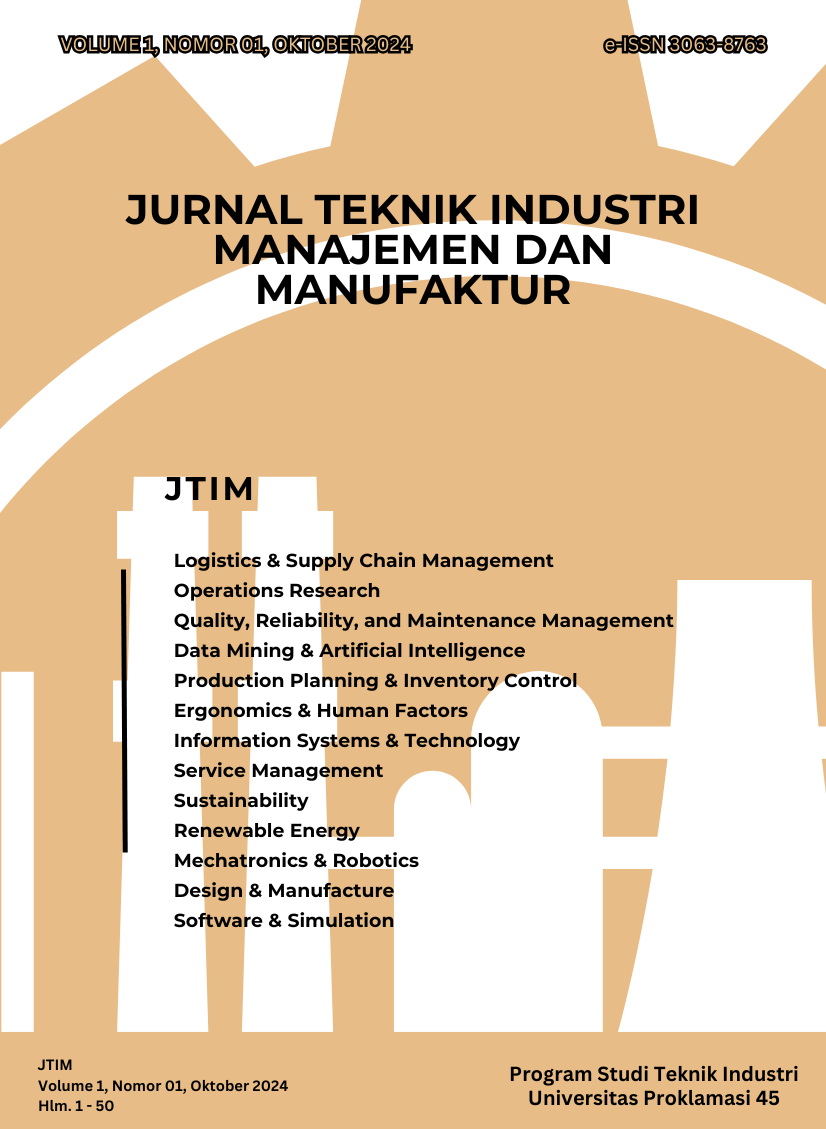PERANCANGAN ALAT DAUR ULANG LIMBAH FILAMENT 3D PRINTING JENIS PLA/PLA+ SEBAGAI BAHAN BAKU PRODUKSI OBJEK 3D
Keywords:
3D Printing, Filament, Recycling, Polylactic Acid (PLA/PLA ), Process Temperature.Abstract
Teknologi pencetakan tiga dimensi (3D printing) berkembang pesat dalam berbagai industri, memungkinkan pembuatan objek presisi tinggi dalam waktu singkat. Namun, penggunaan teknologi ini juga menghasilkan limbah filament 3D yang tidak terurai alami, menyebabkan dampak lingkungan negatif. Solusinya adalah mendaur ulang limbah filament 3D menjadi bahan baku kembali dalam proses 3D printing. Masalah limbah plastik diperparah oleh pencetakan 3D yang populer, meningkatkan jumlah limbah plastik. Pencetakan 3D ekstrusi material, bagian dari manufaktur aditif (AM), digunakan secara luas. Salah satu jenis filament 3D umumnya Polylactic Acid (PLA/PLA+), yang ramah lingkungan karena dapat didaur ulang. Penelitian ini fokus pada dampak variasi suhu dalam proses daur ulang pada sifat fisik dan mekanik filament daur ulang PLA/PLA+. Hasil penelitian menunjukkan suhu 135℃-150℃ dengan pemanasan selama 30 menit dan putaran motor 75 rpm menghasilkan hasil terbaik.References
Babagowda, Kadadevara Math, R. S., Goutham, R., & Srinivas Prasad, K. R. (2018). Study of Effects on Mechanical Properties of PLA Filament which is blended with Recycled PLA Materials. IOP Conference Series: Materials Science and Engineering, 310(1). https://doi.org/10.1088/1757-899X/310/1/012103
Banjaransari, A., Agape Sanjaya, I., Kartika Nusabhakti, I., Paramarta Kusuma, T., Kun Cahyo Utomo, A., & Studi Teknik Mesin Industri, P. (2020). PERANCANGAN MESIN PENGGULUNG FILAMEN PLA DIAMETER 1.75 MM DARI HASIL EKSTRUSI PLASTIK. IMDeC (Industrial and Mechanical Design Conference), 2, 44–50.
Didit Sumardiyanto, & Setiawan Putra. (2021). ALAT PENGOLAHAN LIMBAH FILAMENT 3D PRINTDENGAN MATERIAL POLYLACTIC ACID (PLA). Jurnal Kajian Teknik Mesin, 6(2).
Fajar Ar Rakhman, M. G., Aisyah, S., Toar, H., Studi Mekatronika, P., Elektronika Politeknik Negeri Batam, J., Ahmad Yani, J., Tlk Tering, K., Batam Kota, K., Batam, K., & Kepulauan, P. (2022). Desain Mesin Filament Extruder. Jurnal Integrasi |, 145(2), 2548–9828.
Meijer, L. J. J., van Emmerik, T., van der Ent, R., Schmidt, C., & Lebreton, L. (2021). More than 1000 rivers account for 80% of global riverine plastic emissions into the ocean. Science Advances, 7(18). https://doi.org/10.1126/sciadv.aaz5803
Noor, N., & Triyono, B. (2020). Perancangan Mesin Injeksi Plastik Portabel. Prosiding The 11th Industrial Research Workshop and National Seminar, 26–27.
Sibarani, M., Allan, M. P., & Santika, P. M. (2018). Perancangan unit Extruder pada Mesin Extrusion Lamination Flexible Packaging. JURNAL TEKNIK MESIN – ITI, 2(2).
Downloads
Published
How to Cite
Issue
Section
License
Copyright (c) 2024 Jus Baru Masa Lindo, Syaiful Mansyur, Muchamad Malik

This work is licensed under a Creative Commons Attribution 4.0 International License.
Authors who publish with Jurnal Teknik Industri Manajemen dan Manufaktur agree to the following terms:
Authors retain copyright and grant the Jurnal Teknik Industri Manajemen dan Manufaktur right of first publication with the work simultaneously licensed under a Creative Commons Attribution 4.0 International License that allows others to share (copy and redistribute the material in any medium or format) and adapt (remix, transform, and build upon the material) the work for any purpose, even commercially with an acknowledgment of the work's authorship and initial publication in Jurnal Teknik Industri Manajemen dan Manufaktur
Authors are able to enter into separate, additional contractual arrangements for the non-exclusive distribution of the journal's published version of the work (e.g., post it to an institutional repository or publish it in a book), with an acknowledgment of its initial publication in Jurnal Teknik Industri Manajemen dan Manufaktur. Authors are permitted and encouraged to post their work online (e.g., in institutional repositories or on their website) prior to and during the submission process, as it can lead to productive exchanges, as well as earlier and greater citation of published work (See The Effect of Open Access).

















